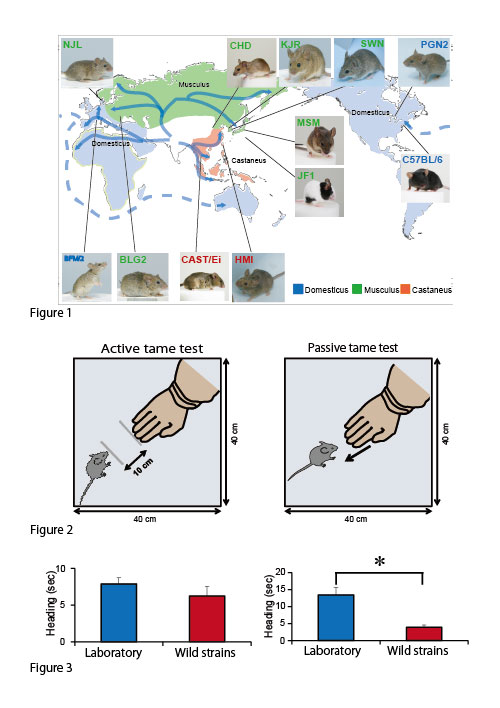A way of making tamed animals from wild mice
Mouse Genomics Resource Laboratory (MGRL) • Koide Group
Tatsuhiko Goto, Akira Tanave, Kazuo Moriwaki, Toshihiko Shiroishi, Tsuyoshi Koide
Genes Brain and Behavior 2013. DOI: 10.1111/gbb.12088
Humans have developed many domestic animals for various purposes. Tameness is a behavioral characteristic that is changed during domestication process of wild ancestors. However, it is still need to be clarified how tameness change the behavior of animals. In this point of view, we took particular note of a book written by an American zoologist, Edward O. Price. He defined tameness as “a measure of the extent to which an individual is reluctant to avoid or motivated to approach humans.” In order to address this point, we developed three behavioral tests to measure the level of two different classes of tameness in mice. We characterized tame behavior using 17 inbred mouse strains: ten wild strains, one Japanese fancy-mouse strain, and six laboratory strains. As a results, most of the domesticated strains showed significantly greater reluctance to avoid humans than wild strains, whereas there was no significant difference in the level of motivation to approach humans between these two groups. These results suggest that domesticated strains were predominantly selected for reluctance to avoid humans over the course of their domestication history.
Dr. Tatsuhiko Goto worked on this project as a project researcher in Transdisciplinary Research Integration Center.

Figure 1. Dr. Kazuo Moriwaki, an emeritus professor, introduced wild mice from many countries and developed wild-derived inbred strains (wild strains). Given that these strains have not been subjected to deliberate attempts at domestication during inbreeding, these mice still show the characteristic behavior of wildness, such as quick movements, aggression, and higher responsiveness to handling by humans.
Figure 2. Tame tests developed for measuring levels of tameness in mice
Figure 3. Most of the domesticated strains showed significantly higher level of reluctance to avoid human than wild-derived mice, whereas there was no significant difference in the level of motivated to approach human.















